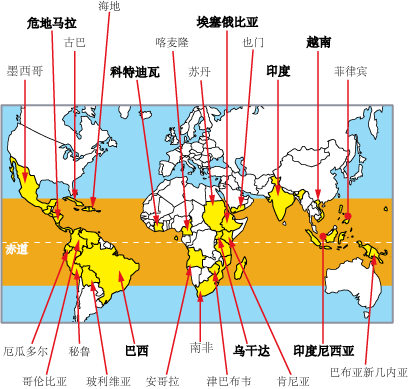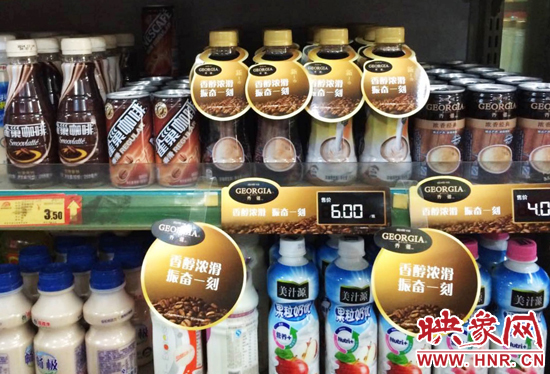Coffee Common sense Coffee grading system summarizes the selection of classification methods in various countries to determine the altitude of coffee origin
First of all, we should know clearly that the factors that ultimately determine the flavor of coffee come from the environment of its producing area, the way of treatment and the quality of raw beans. I believe that without better raw beans, no matter how good the roaster will not bake amazing coffee. Of course, when good coffee beans are in the hands of baristas, baristas should fully understand their characteristics and then add icing on the cake to make more perfect coffee, rather than using subjective cognition to avoid the nature of coffee.
As we all know, after the coffee fruit is picked from the coffee tree, it must be washed or tanned, and the last step in the process is grading. What are the grading methods for raw coffee beans?. Do different countries adopt the same approach? Do you know why we often see a certain coffee bean always have G1, G2, G3. Or AA, AB, AAA such as the grade mark?
At present, there are three main grading standards for raw coffee beans, and different countries adopt different rating methods according to their own production conditions and national conditions (not all coffee producing countries adopt the same method).
Let's introduce these three popular rating methods.
One: classification according to the altitude of the coffee producing area
This classification standard is mainly because the quality of coffee produced at high altitude is generally higher than that at low altitude, because high altitude and low temperature, slow coffee production is conducive to the accumulation of good substances. And the raw beans with high maturity have good expansibility when baking, which is beneficial to baking, and the quality is more stable.
At present, the coffee producers using this classification standard are Central and South American countries such as Guatemala, Mexico, Honduras, El Salvador and so on. Take Guatemala as an example, the most advanced coffee is called SHB (short for Strictly HardBean) very hard beans, which is grown at an altitude above 1350m, followed by HB (HardBean) hard beans, planted at 1200m--1400m above sea level, SH (Semi HardBean) slightly hard beans, EPW (Extra Prime Washed) super quality water washed beans, PW (Prime Washed) high quality water washed beans, EGW (Extra Good Washed) special quality water washed beans, GW (Good Washed) good quality water washed beans, respectively, at an altitude of 1200m. About 1000m, 800m, 600m, 800m, 800m, 600m, 600m, 800m, 800m, 600m, 800m, 800m, 800m, 800m, 800m, 800m, 800m, 800m, 800m, 800m, 800m, 800m, 800m, 600m, 800m, 800m, 600m, 800m, 600m, 800m, 600m, 800m, 600m, 800m, 600m, 800m, 600m, 800m, 600m, 800m, 600m, 800m, 600m, 800m, 600m, 800m, 600m, 800m, 800m, 600m, 800m, 800m, 600m, 800m, 800m, 600m, 800m, 800m, 600m, 800m, 800m, 600m, 800m, 800m, 800m, 800m, 800
Second, grading according to the screen.
The way of sieve grading is to grade according to the size of raw coffee beans. Raw beans are graded by determining the size of the beans through a holed iron plate sieve. The size of the hole in the screen is 1x64 inches (less than 0.4mm), so the size of the screen indicates that there are several 1x64 inches. For example, the size of screen 17 is 17x64 inches, which is about 6.75mm, so the larger the number of the screen, the bigger the particles of raw coffee beans. The reason for this grading is that beans with large grains sell better and are more likely to produce rich and varied flavors than small ones. But this is not to say that beans with large grains are of better quality than beans with small grains. Ethiopian coffee beans are generally narrow and small, but their taste is the most unforgettable and favorite, including Yunnan's small seed coffee. it is also highly appraised by the international market. Kenya is one of the most representative countries rated by sieve, along with Tanzania and Colombia (some countries use more than one classification, and the examples given here are representative, mainly in this way). Kenya's most advanced AA++ requires sieves larger than 18, that is, beans larger than 7.15 mm. Kenya beans are graded carefully, including AA++,AA+,AA,AB and so on. Colombia's classification is simpler, divided into Supremo (selected) and Excelso (upper) according to bean size. 80% of the raw beans of the selected grade need to use a sieve of more than 17, and 80% of the raw beans of the upper grade need a sieve of 14 and more than 16, and a maximum of 11% of the beans with sieve 16 are allowed to be mixed with 14 sieve beans. The screen mentioned above is for flat beans, round beans (Pea Berry) has its own set of screen size standards. Generally use the screen of 8Murray No. 12 to grade the round beans.
Third, grading according to the proportion of screen and defective beans.
Defective beans are an important factor that destroys the flavor of the final coffee. Therefore, defective beans should also be removed in the last step of raw bean processing. Therefore, according to the proportion of defective beans, supplemented by the size of the screen is also used as a way of classification. Due to the rise of boutique coffee, coffee producing countries pay more and more attention to the quality of coffee, and the control of defective beans is the most important way, so basically using the proportion of defective beans as a grading method or auxiliary basis is becoming more and more common.
At present, the main representative countries that use defective bean proportion method are Jamaica, Brazil, Ethiopia and so on. Jamaica is based on the production area, altitude, screen, defective bean proportion comprehensive as the rating standard, defective bean proportion as an important basis. Jamaica strictly controls the proportion of defective beans, and the proportion of defective beans in all grades is no more than 4%.
Brazil is another special country. Brazil is the largest coffee producing country in the world. Because of its large output and many producing areas, the classification work is quite troublesome, and it is not suitable to adopt a single classification standard, so Brazil also uses a variety of classification methods at the same time. Defective bean proportion, sieve and cup evaluation tests are all used in the grading process of Brazilian coffee beans. Needless to say about the first two, the cup evaluation test is one of the characteristics of Brazilian coffee grading.
The so-called cup evaluation test is to evaluate the aroma and taste of raw coffee beans by soaking them in hot water (about 90 degrees) after baking. It is mainly divided into six grades: Strictly Soft extremely mild, Soft mild, Softish slightly mild, Hard difficult, Rio light iodine taste, Rioy strong iodine flavor. The first three grades can be called mild, with a balanced sweet and sour coffee and a mild taste. The latter three taste slightly worse, especially the latter two are the worst. The reason for the iodine smell is that the soil near Rio de Janeiro has a strong iodine smell, and the coffee is dropped on the ground during harvest and is contaminated with the peculiar smell of the adsorbed soil.
The above three are the popular coffee grading methods, but not all of them. For example, Ethiopia will take the handling of raw coffee beans as one of the grading criteria. In addition, there is a more and more widely used COE rating system. As coffee producing countries pay more and more attention to coffee quality and the enthusiasm of producers, the classification of raw coffee beans is not limited to the above three main ways. Only with more careful planting can we produce higher quality coffee and get a high rating in the grade evaluation, so the subdivision and strict control of coffee rating is undoubtedly a good thing for the improvement of coffee quality.
Determination of the selection of classification methods for each country:
1. Generally speaking, coffee is not classified according to altitude in countries near the equator because coffee is grown at a higher altitude. In addition, if it is picked by hand and processed by washing, it will not be graded by bad points because there are few immature beans and sundries mixed in. Therefore, the size of the sieve number is generally used as the grading standard.
Such as Colombia, Tanzania, Kenya
two。 Far from the equator, countries that use washing treatment take the elevation of highlands as the standard of classification because both highlands and lowlands can be planted.
Such as Mexico, Guatemala, Honduras, Costa Rica, El Salvador
3. Mainly by hand picking, but mostly for dry processing. Dry processing is easy to mix with immature beans and other defective beans, so it is classified according to the number of bad points.
Such as Ethiopia, Peru.
4. Except for the countries listed above, almost all of them adopt the sieve size and the number of bad points as the classification criteria.
Such as Brazil, Indonesia, Vietnam, Jamaica

Important Notice :
前街咖啡 FrontStreet Coffee has moved to new addredd:
FrontStreet Coffee Address: 315,Donghua East Road,GuangZhou
Tel:020 38364473
- Prev

Coffee news Starbucks new breed Starbucks cold iced coffee waiting for summer ice and fire singer Ba
At the turn of spring and summer, there are undoubtedly two legends of ice and fire to look forward to, one is HBO's Song of Ice and Fire: game of Thrones, and the other is Starbucks cold iced coffee. The same ingenuity, the same limited-time production, and the same interpretation of the classic legends of ice and fire have attracted many loving fans. The only difference is that the former is a wonderful story in a fantasy epic.
- Next

The latest coffee news ready-to-drink coffee this summer the beverage giant is still adding size to the strategic partnership between Nestl é and Alibaba.
The data show that China's coffee market is growing at an annual rate of 15% and 20%. Among them, the compound growth rate of instant coffee is as high as 34.2%. From Coca-Cola's high-profile launch of Qiaoya, Yibao teamed up with Japanese Kirin Hot Cafe, Starbucks chose to meet with Master Kang's petty bourgeoisie, and uniformly launched the new ready-to-drink coffee strategy Yaha hey series, Wa also launched Maoyuan Coffee.
Related
- How did the Salvadoran coffee industry develop in Central America?
- What exactly does the golden cup extraction of coffee mean?
- The Origin of Coffee flower
- [2023 Starbucks World Earth Day] there are more meaningful things besides free Starbucks coffee!
- What kind of coffee is there in Spain? 9 Flavors of Spanish Coffee
- Aromatic African coffee| Kenya's coffee culture and historical production area
- Liberica Coffee Bean knowledge: the characteristics of Liberian Coffee beans of the three original species of Coffee beans
- The origin and formula of Spanish latte introduces the taste characteristics of Bombon coffee in Valencia, Spain.
- How to adjust the solution of over-extracted coffee
- What is the tasting period of coffee beans? What is the period of coffee and beans? How should coffee wake up and raise beans?

